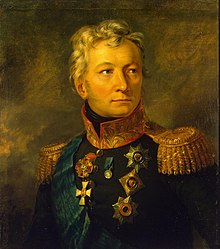Alexander Petrovich Tormassow
Count Alexander Petrovich Tormasov ( Russian Александр Петрович Тормасов , scientific transliteration Aleksandr Petrovič Tormasov , born August 22, 1752 , † November 25, 1819 in St. Petersburg ) was the Russian cavalry general and most recently governor of Moscow.
origin
He comes from a Russian military family, and his grandfather fought in the navy under Peter the Great .
Life
He came to the Tsar's court as a page in 1762 and was transferred to the Vytka Infantry Regiment as a lieutenant on March 13, 1772 . In May he became a captain and joined Count Bruce as adjutant . In 1774 he became the commander of the division in Finland . Tormasov became a lieutenant colonel and in 1777 commander of the Finnish Jäger Battalion. He was then transferred to the Crimea from 1782 to 1783 and in 1784 was given command of the Hussar Regiment (Light Horse) Alexksandria .
He distinguished himself in the campaigns against the Turks from 1787 to 1792 . He fought in the siege of Ochakov, in the battle of Kuchani and in the assault on Akjermann and Bender, as well as in Babadagh and Matschin. During that time he became a Brigadier on April 5, 1789 and Major General on April 1, 1791 . For Babadagh and Matschin he received the Order of St. George 3rd Class on March 29, 1792 .
He was posted to Poland in 1792 and fought at Lübar, Matschewishi and the assault on Praga. For this he received the Polish Order of the White Eagle , the Order of St. Stanislaus 2nd Class and the Order of St. Vladimir 2nd Class, and he also received a gold sword with diamonds.
In 1794 he fought against the Poles under Igelström , but was defeated on April 4th by Kosciusko near Raclawice and forced to retreat.
On December 14, 1796 he was promoted to lieutenant general and chief of a cuirassier regiment. After falling out of favor with Tsar Paul I in 1799, he was released on July 23, 1799.
He returned on November 28, 1800 and became commander of the life guards on horseback. On September 27, 1801 he was then appointed General of the Cavalry, on July 23, 1801 inspector of the Dniester inspection and on February 20, 1802 inspector of the Livonia inspection.
In 1802 he withdrew briefly before he was appointed military governor of Kiev on February 7, 1803 . In 1804 he received the Gubernia estate in Courland . But in 1805 he began to reorganize the Dniester army against the Turks. In 1806 he had to take a break due to health problems, but received the Alexander Nevsky Order . From March 28, 1807 to December 23, 1807 he was then military governor of Riga , but had to give up the office for health reasons.
On June 21, 1808 he returned to the army and on September 15, 1808 commander of the troops in Georgia and the Caucasus . He took Yerevan by storm, defeated the Persians at Elisabethpol, conquered Imeretia in 1810 and defeated the Turkish-Persian army at Zalki. In the Franco-Russian War of 1812 , Tormasov commanded the Third Western Army. He covered Volhynia with this , advanced in July in the rear of the French general Reynier , defeated him on July 15 at Kobryn , but had to retreat from Reynier and Schwarzenberg after the battle of Podobna . When the Moldovan Army arrived, he handed over the command of Chichagov and took over the command of the reserve of the main army in Bagration's place with which he worried the withdrawal of the French from Moscow. In the campaign of 1813 he commanded the reserve near Leipzig but then gave the order to Grand Duke Constantine and returned to Russia. There he was appointed Governor of Moscow in 1814 in place of General Rostoptschin Infantry, for whose reconstruction he did a great deal. He died in this position on November 25, 1819 and was buried in the Donskoy monastery .
literature
- Allgemeine Militair-Encyclopädie , Volume 9, p. 267
- General German Real Encyclopedia for the Educated Estates , Volume 14, p. 338
- Alexander Mikaberidze: Russian Officer Corps of the Revolutionary and Napoleonic Wars , p. 401, partial view
Web links
Individual evidence
- Jump up ↑ Berlinische Nachrichten von Staats- und schehrten Dinge: 1819 , 10/12, p. 138.
- ^ Bote für Tirol: Official Journal of the Authorities, Offices and Courts of Tirol. 1814, 7/12, p. 237.
| personal data | |
|---|---|
| SURNAME | Tormassow, Alexander Petrovich |
| ALTERNATIVE NAMES | Tormasov, Aleksandr Petrovič; Тормасов, Александр Петрович (Russian) |
| BRIEF DESCRIPTION | Russian general of the cavalry and most recently governor of Moscow |
| DATE OF BIRTH | August 22, 1752 |
| DATE OF DEATH | November 25, 1819 |
| Place of death | St. Petersburg |
